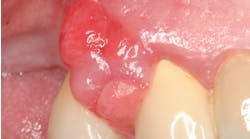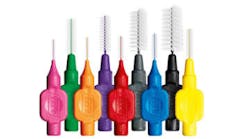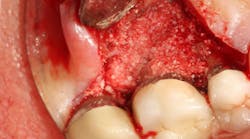This sweet, effective alternative to prevent dental decay is xylitol! Xylitol is a natural sweetener (polyol) that is derived from plant fibers such as fruits, vegetables, birch trees, and corncobs. We consume about 8 to 10 grams daily in our diet, and humans naturally synthesize xylitol in the liver, which is essential for the conversion of food to energy. The beauty of xylitol is that it is considered to be nonfermentable by oral bacteria because it consists of a 5-carbon chain. Bacteria need a 6-carbon chain food source to metabolize, cell divide, and colonize. Mutans streptococcus (MS) cannot digest a 5-carbon chain. The xylitol is sweet and tricks the bacteria into attempting to use it as a food source. The MS ingests the sweetener but cannot digest it; therefore, it cannot produce polysaccharides that allow the bacterial cells to stick to one another, the teeth, or tissues. The xylitol also encapsulates the existing bacteria and reduces the stickiness so the affected bacteria break away from the existing biofilm, reducing the plaque and harmful MS that cause caries. Xylitol is bacteriostatic and shows both noncariogenic and cariostatic properties.
Think about what this means for dental caries ... considered a common disease, second to the common cold! Studies show that not only is xylitol effective in reducing MS and dental decay when using it as a therapeutic dose and exposure on a habitual level for six months, but it has a latent effect as well for two years when discontinued.
The recommended exposure protocol for xylitol is five to eight times daily, at a minimum of 1 gram per exposure with a total of 8 to 10 grams per day ... Strive for Five! The exposure time is five minutes, with preferably no rinsing or eating for 15 minutes to allow the MS to bathe and ingest the xylitol.
Xylitol products vary, so reading labels is important. For example, if the label on the product lists other natural sugarless sweeteners such as sorbitol, mannitol, or maltitol — which all consist of a 6-carbon chain — the xylitol will be competing with those other sweeteners and, therefore, be less effective. When reading product labels, make sure that xylitol is the first ingredient and that no other sweeteners are listed.
Xylitol addresses four areas of concern for dental caries:
- Reduces Mutans streptococcus.
- Increases saliva because of the hygroscopic qualities that causes a cooling effect, which brings water to the area.
- Raises the pH of saliva two ways: xylitol pH is 6.5 and reduces the MS and formation of acids.
- Remineralizes the enamel by increasing saliva, raising the pH, and increasing the uptake of calcium ions into the tooth surface.
Typical xylitol products include chewing gum, mints, candies, toothpaste, mouthrinse, and gels and can be found in health food stores, dental distributors, and online.
Xylitol testing has found this natural “miracle” sweetener to be completely safe for all ages. It is well tolerated by children up to 40 grams per day. Exceeding that amount may cause a laxative effect until the body adjusts. It is important to note that dogs and ferrets cannot tolerate xylitol; it is harmful to their metabolic system. Keep xylitol away from all pets.
Quality xylitol products can be found more readily in health food stores and pharmacies, but it is starting to appear in regular grocery stores.
Author bio
Lisa E. Stillman, RDH, BS, is the northeast xylitol educator for Wasatch sales force. She teaches dental health professionals the general and dental health benefits of quality xylitol products with presentations and literature and assists dental offices in incorporating xylitol into the dental hygiene protocol. She has practiced dental hygiene in Maryland and Virginia and currently has a position specializing in periodontics.Lisa has developed an organization called Dental Voice for Mental Health that assists mental health care recipients in caring for their oral health through awareness and education. She presents courses to her colleagues, mental health professionals, facilities, advocacy groups, and writes articles to promote oral health for this underserved population. Lisa is featured in the Bipolar Magazine and Schizophrenia Digest concerning oral health. She was the 2008 Sunstar/RDH Award of Distinction Recipient, is a member of American Dental Hygienists Association and the National Alliance of the Mentally Ill, and is a founding member of the American Academy of Oral Systemic Health. You may contact Lisa at [email protected].
References
• Olsson H, Spak CJ, Axell T. The effect of a chewing gum on salivary secretion, oral mucosal friction, and the feeling of dry mouth in xerostomic patients. Acta Odontologica Scandinavia 1991; 49:273-279.
• Hujoel PP, Mäkinen KK, Bennett CA, et al. The optimum time to initiate habitual xylitol gum-chewing for obtaining long-term caries prevention. Journal of Dental Research 1999; 78(3):797-803.
• Coldwell SE, Oswald TK, Reed DR. A marker of growth differs between adolescents with high vs. low sugar preference. Behavior Physiology March 2009; 96(23)574-580.
• Isotupa KP, Gunn S, Chen CY, Lopatin D, Mäkinen KK. Effect of polyol gums on dental plaque in orthodontic patients. American Journal of Orthodontics and Dentalfacial Orthopedics1995; 107:497-504.
• Miake Y, Takahashi M, Saeki Y, Yanagisawa T. Effect of xylitol on remineralization of demineralized enamel. The Shikwa Gakuho 1999 (Japanese); 99:393-399.
• Yanagisawa T, Miake Y. Prevention of caries and restoration of initial enamel caries by remineralization enhanced with xylitol +2 gum. Finnish Dental Journal 2006; 13(1):44-49.
• Brin M, Miller ON. The safety of oral xylitol IN: “Sugars in Nutrition” (HL Sipple, KW McNutt, eds.), Academic Press, New York 1974; 591-605.







